Asobo’s KSEA Seattle-Tacoma Airport
Every iteration of Microsoft Flight Simulator brings new features, in part because of the evolution of the hardware which enables us to fly. The latest release was no different and this simulation has come a long way in ten years.
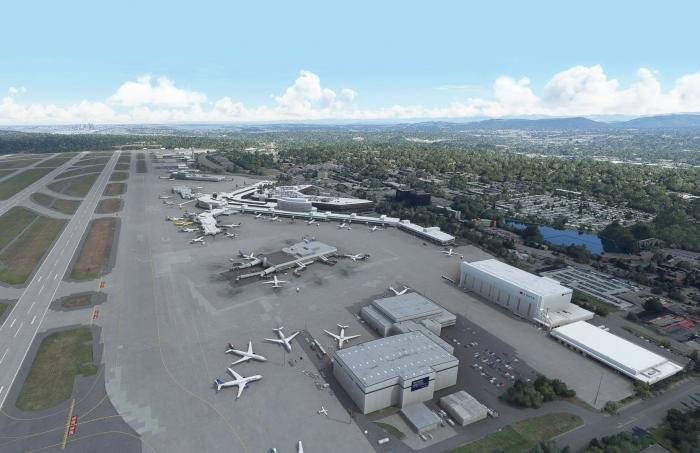
After not flying for four or five years, I walked into an office where someone was flying Microsoft Flight Simulator (MSFS) late in 2020 and wondered if I was seeing a movie or a documentary. New GPUs and the supporting APIs enable incredible features, and immersion has been taken to a new level in the latest iteration of the sim. It’s an earth and sky simulator as much as an aircraft and flight simulator. And with some of the aircraft now being added, it’s also an avionics and systems simulator.
At higher levels of challenge, it’s incredibly immersive. Flying an A320 on a precision landing in poor weather, one can really break into a sweat. If you have added Navigraph charts and learned the intricacies of the flight computer, your gate-to-gate time has increased as has the fun. Yet that immersive experience can quickly be lost when departing from the gate of a default Asobo airport.
Let’s face it, even a basic Asobo airport in MSFS now is better than most of the last generation. But when the new features and possibilities of this next-generation simulation are truly leveraged, it becomes difficult to distinguish the simulation from reality. Let me offer just a few snapshots of what I have noticed.
I’ve seen realistic ground workers chatting near a gate or power unit, tyre marks around gates in dry or in wet weather that look absolutely real, airport interiors modelled to fine detail, including animated passengers, LED displays showing arrivals and departures and moving escalators.
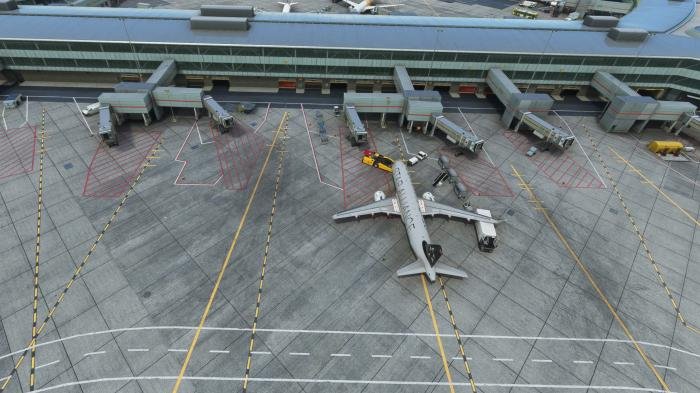
I’ve seen night lighting and transparent glass with reflections of near objects that are absolutely realistic.
I’ve also seen Visual Docking Guidance Systems (VDGS) and control tower views that offer a 360-degree view of the real-time action at a given airport.
However, there’s a catch. If you want this level of detail, you have to add third-party airports. The designs I have been looking at are very good and this series will take you there. Many MSFS airport builders are obsessive to the extreme and are using their best talents to take us there.
We’ll begin by exploring a default Asobo airport to create a baseline. In that process, we’ll set out a standardised way of measuring certain prominent design features: overall texture quality, lighting, gates and jetways, buildings accurate to the real airport, lines and signage and weathering. And we’ll consider special features including operating trams and trains, realistic interiors, animations and the new VDGS systems. So, let’s taxi to the runway at KSEA (the ICAO (International Civil Aviation Organization) code for Seattle–Tacoma International Airport).
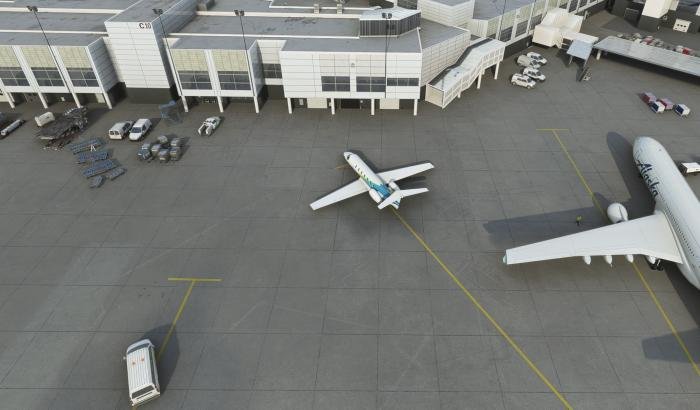
Asobo’s KSEA Seattle-Tacoma Airport
The first thing I notice on approach at Sea-Tac is some lovely detail on the PAPI (Precision Approach Path Indicator) system. During my taxi time, however, I begin to notice the missing lines. Moreover, I’m not seeing much wear or rubber on the taxiways. Textures are too clean. When I arrive at the gate that impression continues; I don’t think it ever rains in this version of Seattle. Where is the weathering? And the glass in the terminal face is reflective but looks fake. There is no transparency, and the windows are too uniform and boxy.
Around the gate area the yellow lines are too crisp, and the tarmac looks almost unused. The guidelines for vehicle traffic have disappeared and the white lines that restrict where ground vehicles and carts and the like will be parked are similarly missing.
On the other hand, the layout of the airport is mostly right. Comparing satellite imagery with the in-game buildings and taxiways, they are the right size and location. However, roof detail is often lacking, with no ventilation units or air conditioners. Certain features are also missing from some parts of the terminal, such as the covered walkway from the north ramp area.
Gates are also missing at some parts of the terminal along with some other details. Small red or yellow signs announce warnings or instructions around doors and gates at the actual airport but not here.
Details at gates are sparse and jetways at KSEA are the Asobo default. They have basic details but lack features that appear in nearly every upgrade. They lack the weathering seen on better jetways and the animations are rather weak, having a nasty habit of intruding through the aircraft skin.
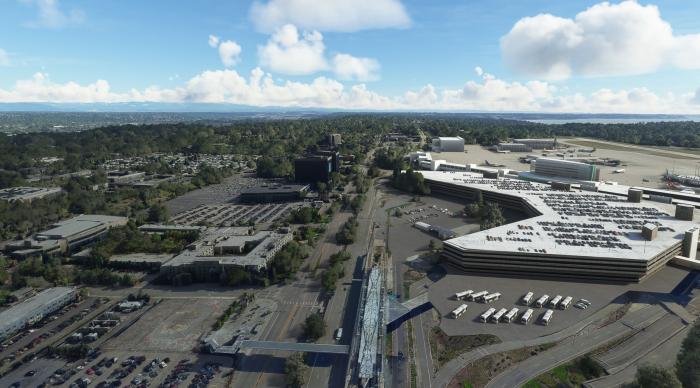
The passenger side of the terminal has been neglected. Some might say: "Who cares? It's not like we park aircraft there or even taxi there. It’s not Microsoft Passenger Simulator, after all?"
But for a sense of immersion when you are low and slow in a C172, that detail becomes critical. Or if you happen to be in drone view taking screenshots, you want to see a realistic and familiar view. What if the control tower views we are seeing appear now become a standard feature? With that elevated 360 perspective, you will need those areas added to see the kind of design detail that is now appearing at CYYZ (Toronto Pearson International), NZAA (Auckland International Airport), EBBR (Brussels Airport) and others. At KSEA, however, the passenger side has received virtually no attention, depending mostly on default satellite mapping.
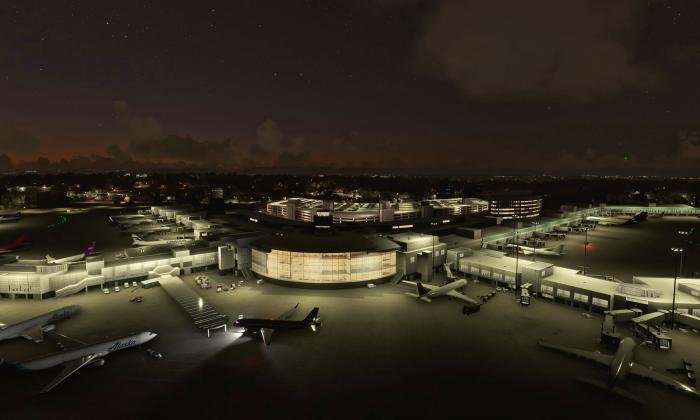
Night lighting, on the other hand, is okay. It’s just warm enough, not the glaring white that appears at some airports. But it only looks decent until you get near to the terminal buildings, then the lack of transparency is noticeable and detracts from that sense of ‘being there.’ And it’s even worse if you have newer airport expansions where the lighting is realistic. When you return to these Asobo defaults you feel like you are in a cartoon. In daylight, KSEA is bearable, at least if you are not frequenting the real-world airport.
Other problems soon show up. Aircraft are taxiing at odd places and don’t follow the lines. The tower is not going to like this and neither are you if you attempt to follow the rules when the AI does not. And it’s really annoying when you pull up to your gate only to find a transit bus pulling up beside you at the next gate.
Hardware test
Finally, I did some hardware testing to see how framerates compare at these default MSFS airports versus the beautiful third-party airports currently arriving on the scene; the results surprised me. In order to make a reasonable comparison, here are my settings. I am running on full ULTRA graphics settings at 2560x1440. My system is an AMD Ryzen 5900 with 16MB DDR4 at 3600MHz. The GPU is an EVGA RTX 3060 with 12GB of RAM.
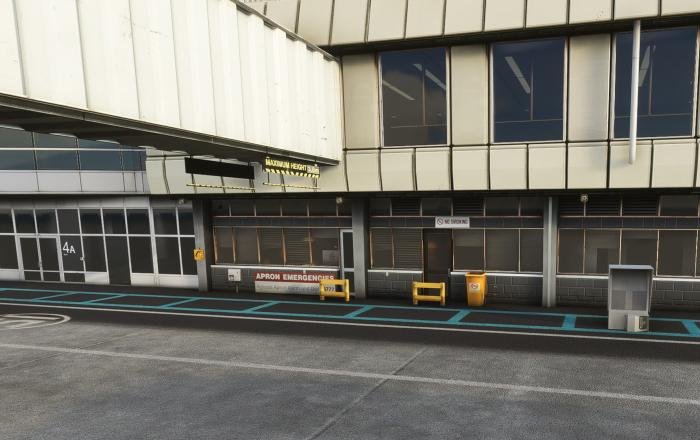
The framerate at KSEA at the gate in the FlyByWire A320 is 25FPS, at CYVR (Vancouver International Airport) from FSim Studios, it’s 36FPS. At CYYZ (Toronto Pearson International) from FlyTampa, it’s 30FPS while at NZAA (Auckland International Airport) from Flightbeam, it’s 38FPS. That’s surprising, right?
The default and very basic Asobo KSEA offers the worst framerate of any of the airports I am testing. The most likely reason is lack of optimisation and failure to take advantage of the newer capabilities of graphic design and graphics hardware.
So, when you find that airport that you really want to add to MSFS, chances are it will ease your hardware burden and not increase it.
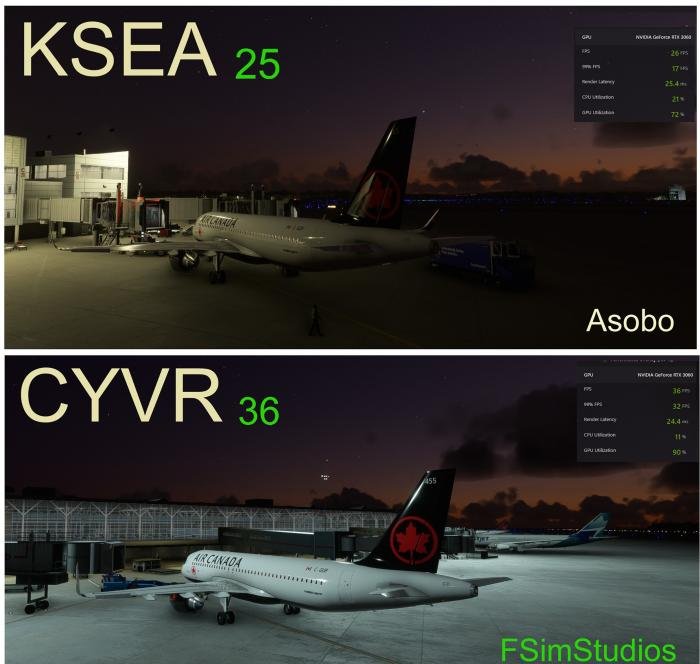
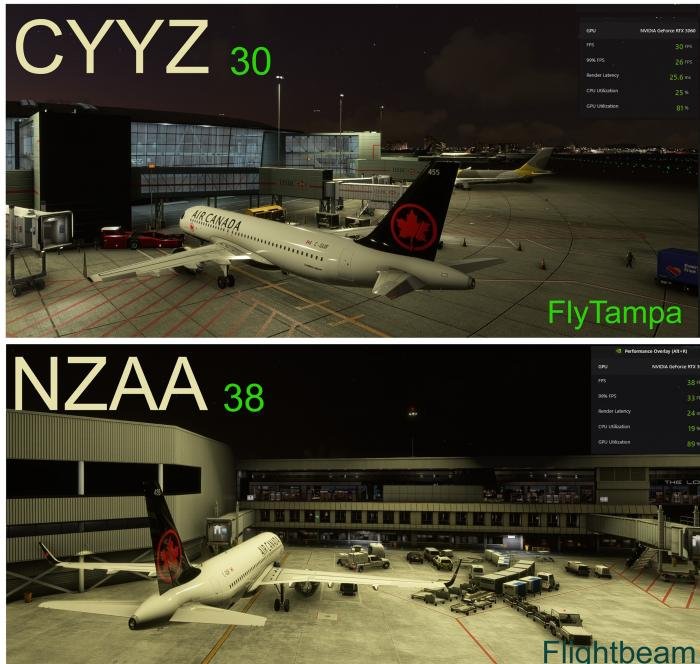
Conclusion
Let me summarise what we have seen at KSEA and offer a rating. Let’s break it down like this:
Imaging – texture quality, look and feel, tarmac and gate details including lines and tyre marks, lighting and glass (animations we will rate under Realism).
Score: 6/10
Enhancements – Additional Points of Interest (POIs) or area enhancement, unique features, such as working trams and trains, new views like the control tower, improved jetways, opening hangars and VDGS system.
Score: N/A
Realism – Terminal interiors, animations (usually people), signage in detail, static aircraft and objects, gates and buildings where they should be. Runways are accurate. The vehicle and passenger side of the terminal properly modelled.
Score: 4/10
Overall KSEA score: 4/10
That’s all for Round 1. In part 2 of this series, starting on page 54, we will look at Pearson (CYYZ), FlyTampa’s offering for international fliers.
It’s evident from this beginning that PC pilots of all stripes have a lot to look forward to as our list of expansion airports grows.
By Len ‘Flightdoc’ Hjalmarson

